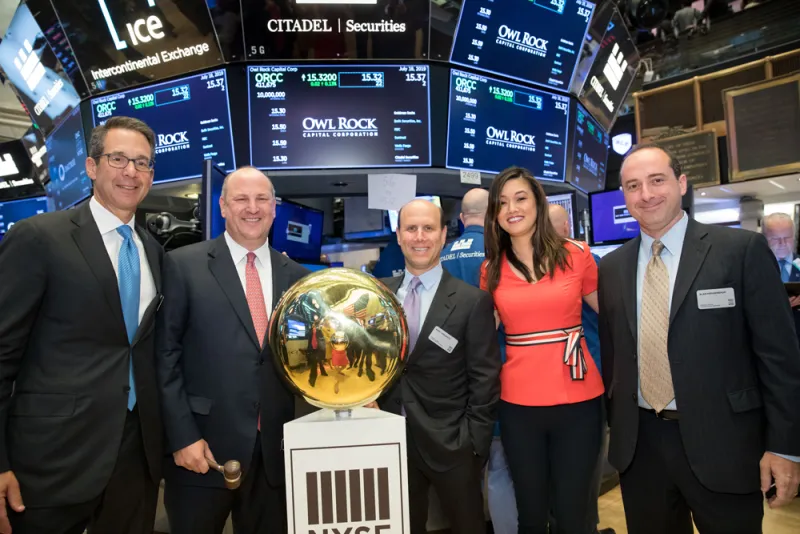Business development companies got a little more institutional with the initial public offering Thursday of Owl Rock Capital Corp., a business development company that lends to a broad range of middle-market companies.
Owl Rock Capital Partners, which operates the BDC, was started in 2016 by three well-known private credit veterans: Doug Ostrover, co-founder of Blackstone Group’s GSO Capital Partners; Marc Lipschultz, KKR’s former global head of energy and infrastructure; and Craig Packer, who was co-head of leveraged finance for the Americas at Goldman Sachs. Owl Rock initially raised $5.5 billion — more than 80 percent of which was institutional — from investors including New Jersey’s state pension fund, Brown University, and MSD Private Capital, Michael Dell’s family office.
ORCC priced the IPO at $15.30 and issued ten million shares on the New York Stock Exchange. The shares opened at $15.50.
BDCs are vehicles like mutual funds, real estate investment trusts, and master limited partnerships, but which make loans, many of which support private equity deals. BDCs, like REITs almost two decades ago, want institutional investors and the scale that comes with them.
In recent years, the largest asset managers — including Blackstone, KKR, Carlyle, Ares, TPG, and Franklin Templeton — have been building initiatives to offer the still-arcane product, which has historically been geared to retail investors.
But Packer, president of ORCC, said in an interview that the founders built the entire business with institutions in mind.
“If you raise money in the retail channel, it takes a long time to scale,” said Packer. “And while you do that, you have to invest in smaller deals. Because we raised $5.5 billion in equity, and with leverage scaled that to $10 billion, we could invest in larger companies from the very beginning.”
Packer said these kinds of companies are “materially better” than ones Owl Rock would have access to if it had to operate with a smaller pool of capital. “Our investors want the returns you get from illiquid securities, but they also want safety,” he added.
Although the BDC market is still a small part of private credit, Ostrover expects that to grow, stressing the benefits that BDCs offer over other traditional institutional funds that invest in private credit. For one, investors are putting money into a portfolio that is already invested.
“A GP/LP fund is a blind pool. You invest over four years, say, and then you get your money back. But you don’t know your return until the last loan is paid off, and that could be in year nine,” said Ostrover. “With us you know exactly what you are buying and you can analyze the loans. And then you go into the market, and put $100 million to work right away.”
Ostrover added that with BDCs, shareholders get dividends the following quarter, rather than having to wait until a manager puts money to work through a traditional fund, and can sell shares at any time.
[II Deep Dive: BDC Guru Jonathan Bock Departs Wells Fargo]
As for fears about the flood of money going into private credit from institutional investors in recent years, Packer pointed out that private debt has grown, but nearly as quickly as its primary driver: private equity. The proportion of private equity that private lending represents has actually gone down. “We think there are tremendous growth opportunities ahead,” he said. “It’s still a small fraction of the private equity market. Every dollar of PE needs five dollars of debt.”
Many BDCs trade at discounts to their net asset values, but a more institutional client base could straighten that out, Owl Rock’s principals said.
“The market is becoming bifurcated,” said Ostrover. “There are firms that have invested in energy, retailers, and others, and they’ve had losses and trade at a discount. But there are others that trade at a large premium because they’ve delivered a steady stream of income and avoided troubled sectors.”







